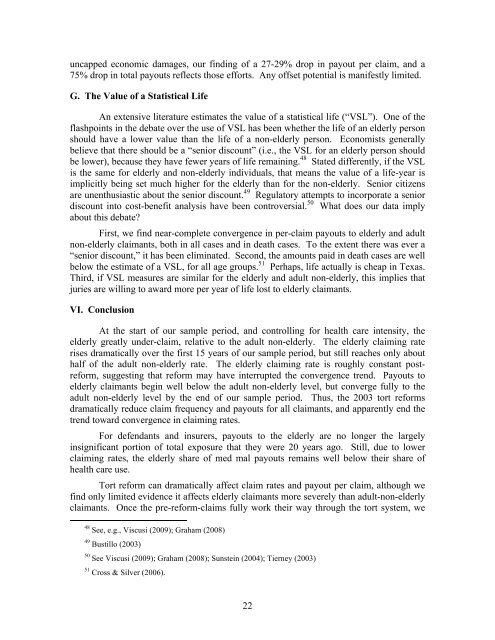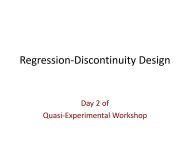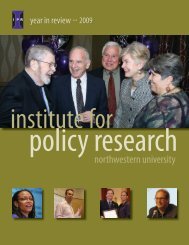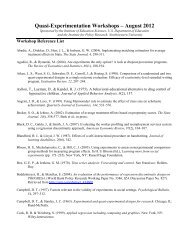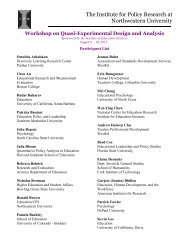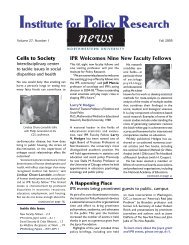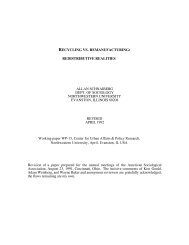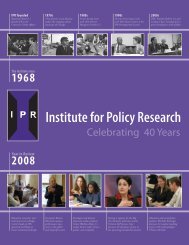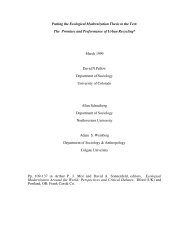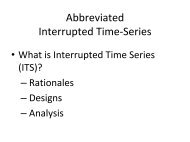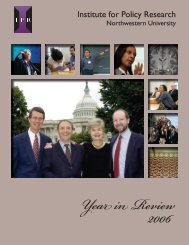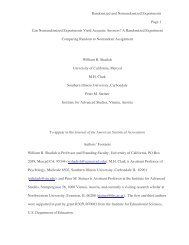Download working paper PDF - Institute for Policy Research ...
Download working paper PDF - Institute for Policy Research ...
Download working paper PDF - Institute for Policy Research ...
Create successful ePaper yourself
Turn your PDF publications into a flip-book with our unique Google optimized e-Paper software.
uncapped economic damages, our finding of a 27-29% drop in payout per claim, and a<br />
75% drop in total payouts reflects those ef<strong>for</strong>ts. Any offset potential is manifestly limited.<br />
G. The Value of a Statistical Life<br />
An extensive literature estimates the value of a statistical life (“VSL”). One of the<br />
flashpoints in the debate over the use of VSL has been whether the life of an elderly person<br />
should have a lower value than the life of a non-elderly person. Economists generally<br />
believe that there should be a “senior discount” (i.e., the VSL <strong>for</strong> an elderly person should<br />
be lower), because they have fewer years of life remaining. 48 Stated differently, if the VSL<br />
is the same <strong>for</strong> elderly and non-elderly individuals, that means the value of a life-year is<br />
implicitly being set much higher <strong>for</strong> the elderly than <strong>for</strong> the non-elderly. Senior citizens<br />
are unenthusiastic about the senior discount. 49 Regulatory attempts to incorporate a senior<br />
discount into cost-benefit analysis have been controversial. 50 What does our data imply<br />
about this debate?<br />
First, we find near-complete convergence in per-claim payouts to elderly and adult<br />
non-elderly claimants, both in all cases and in death cases. To the extent there was ever a<br />
“senior discount,” it has been eliminated. Second, the amounts paid in death cases are well<br />
below the estimate of a VSL, <strong>for</strong> all age groups. 51 Perhaps, life actually is cheap in Texas.<br />
Third, if VSL measures are similar <strong>for</strong> the elderly and adult non-elderly, this implies that<br />
juries are willing to award more per year of life lost to elderly claimants.<br />
VI. Conclusion<br />
At the start of our sample period, and controlling <strong>for</strong> health care intensity, the<br />
elderly greatly under-claim, relative to the adult non-elderly. The elderly claiming rate<br />
rises dramatically over the first 15 years of our sample period, but still reaches only about<br />
half of the adult non-elderly rate. The elderly claiming rate is roughly constant postre<strong>for</strong>m,<br />
suggesting that re<strong>for</strong>m may have interrupted the convergence trend. Payouts to<br />
elderly claimants begin well below the adult non-elderly level, but converge fully to the<br />
adult non-elderly level by the end of our sample period. Thus, the 2003 tort re<strong>for</strong>ms<br />
dramatically reduce claim frequency and payouts <strong>for</strong> all claimants, and apparently end the<br />
trend toward convergence in claiming rates.<br />
For defendants and insurers, payouts to the elderly are no longer the largely<br />
insignificant portion of total exposure that they were 20 years ago. Still, due to lower<br />
claiming rates, the elderly share of med mal payouts remains well below their share of<br />
health care use.<br />
Tort re<strong>for</strong>m can dramatically affect claim rates and payout per claim, although we<br />
find only limited evidence it affects elderly claimants more severely than adult-non-elderly<br />
claimants. Once the pre-re<strong>for</strong>m-claims fully work their way through the tort system, we<br />
48 See, e.g., Viscusi (2009); Graham (2008)<br />
49 Bustillo (2003)<br />
50 See Viscusi (2009); Graham (2008); Sunstein (2004); Tierney (2003)<br />
51 Cross & Silver (2006).<br />
22


